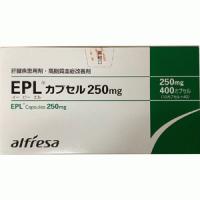アルフレッサファーマ
EPL Polyene Phosphatidylcholine Capsules/Polyene Phosphatidylcholine Japanese fatty liver hyperlipidemia improves liver function alcoholic liver 250mg 400 tablets/box
EPL Polyene Phosphatidylcholine Capsules/Polyene Phosphatidylcholine Japanese fatty liver hyperlipidemia improves liver function alcoholic liver 250mg 400 tablets/box
Couldn't load pickup availability
1. Basic information of the drug
- Common name : Polyene phosphatidylcholine
- English Name : Polyenephosphatidylcholine
- Product Name : EPL Capsules 250mg (Post-Epileptic Product)
- Dosage form : Capsules
- Indications : Used to improve liver function in chronic liver diseases, fatty liver, and hyperlipidemia.
- Ingredients : The main ingredient is polyene phosphatidylcholine.
- Properties : The content is a white to slightly yellow oily liquid with a peculiar odor. It is easily oxidized in the air and its color changes from yellow to brown.
2. Usage and Dosage
Generally, adults take 500 mg (in terms of polyene phosphatidylcholine) orally three times a day. The dosage can be appropriately increased or decreased according to age and symptoms.
3. Taboo
Patients with a history of allergy to the ingredients of this drug are prohibited from using it.
IV. Precautions
- Special populations : Breastfeeding women need to consider the benefits of treatment and the nutritional benefits of breast milk to decide whether to continue breastfeeding.
- Medication Instructions : When taking PTP -packaged medicines, patients should be instructed to take the medicines out of the PTP sheet before taking them to avoid accidental swallowing of the PTP sheet, as its hard and sharp corners may pierce the esophageal mucosa and even cause perforation, leading to serious complications such as mediastinitis.
- Drug storage : Drugs should not be stored in high temperature and high humidity environments, otherwise the liquid contents may leak out.
5. Adverse Reactions
- Allergic reaction : Allergic symptoms such as rash may occur (incidence less than 0.1% ).
- Digestive system reactions : diarrhea, stomach discomfort, abdominal distension, nausea, etc. may occur (incidence 0.1 - 5% or less). If the above adverse reactions occur, close observation should be made. If abnormalities occur, the drug should be discontinued and appropriate measures should be taken.
6. Drug Interactions
There is currently no clear information on the interaction between this drug and other drugs. If you need to take other drugs at the same time, please consult a doctor or pharmacist.
7. Pharmacological Action
- Adjusting biomembrane function : It can adjust the morphology and function of human biomembranes, correct the extracellular escape of enzymes (verified in rat experiments and in vitro experiments), and maintain intracellular enzyme activity (verified in rat experiments).
- Improve metabolic abnormalities : It can improve abnormal lipid metabolism in cells of humans and rabbits when they are sick, and then improve various cellular functions such as protein metabolism and cholesterol release function.
- Regulating blood lipids : By improving lipid metabolism and protein metabolism, improving the lipoprotein composition of human blood, and regulating the metabolic turnover of cholesterol, it has the effects of improving the cholesterol ester ratio, restoring cholesterol dissimilation and excretion disorders to normal (verified in rat and human experiments).
- Protect blood vessels : It can improve the decrease in vascular elasticity caused by vascular endothelial damage (verified in human experiments), inhibit the abnormal hyperpermeability of blood vessels (verified in rat experiments), and normalize the hyperactivity of the blood coagulation system (verified in in vitro experiments).
8. Pharmacokinetics
- Absorption : After 5 foreign patients with hyperlipidemia took 1g of 3H , 1⁴C - dialeoylglycerophosphocholine orally, more than 90% of the radioactivity of both was absorbed from the small intestine.
- Excretion : After administration to these 5 patients, the radioactivity of ³H and ¹⁴ C in feces were 2±0.7% and 4.5±1.5% of the administered dose, respectively, and the radioactivity of ³H and ¹⁴ C in urine were 6±0.8% and 1.2±0.4% , respectively.
IX. Clinical Research
- Hyperlipidemia
- Domestic Phase III double-blind comparative trial : patients with hyperlipidemia were given polyene phosphatidylcholine 1500 mg/ day or placebo for 4 consecutive weeks. The results showed that the total cholesterol in the polyene phosphatidylcholine group ( 65 cases) was significantly lower than that in the placebo group ( 56 cases), and the comprehensive improvement of serum total cholesterol and the evaluation of the attending physician was significantly improved. The side effects of the polyene phosphatidylcholine group included a tendency to soft stools ( 5.7% , 4/70 cases), stomach discomfort ( 2.9% , 2/70 cases), and diarrhea ( 1.4% , 1/70 cases).
- Effect test on serum lipoprotein components and ApoA protein concentration : 16 patients with hyperlipidemia and low HDL- cholesterolemia were given polyene phosphatidylcholine 1500 mg/ day for 12 consecutive weeks. The results showed that after administration, HDL- cholesterol and apolipoprotein A-I increased significantly, and the LDL- cholesterol /HDL- cholesterol ratio decreased significantly.
- Chronic liver disease
- Domestic Phase III double-blind comparative trial : patients with chronic hepatitis were given polyene phosphatidylcholine 1500 mg/ day or placebo for 12 consecutive weeks. The results showed that the polyene phosphatidylcholine group ( 58 cases) had significantly improved subjective and subjective symptoms and liver function compared with the placebo group ( 66 cases), and no side effects were found.
- A trial using liver biopsy images as an indicator : patients with chronic hepatitis were given 1500 mg of polyene phosphatidylcholine per day for 6 consecutive months. Liver biopsy images were evaluated using a single-blind method, and the results showed that the polyene phosphatidylcholine group ( 17 cases) had significantly improved or improved liver biopsy findings compared to the control group ( 17 cases), and no side effects were found.
10. Packaging specifications
- 400 tablets: [10 tablets ( PTP ) × 40]
- 1000 tablets: [10 tablets ( PTP ) × 100]
- 400 capsules: [ Plastic bag, bulk ]
11. Production Information
- Manufacturer : Alfresa Pharmaceuticals Co., Ltd.
- Company address : 2-2-9 , Ishimachi, Chuo-ku, Osaka
Share

